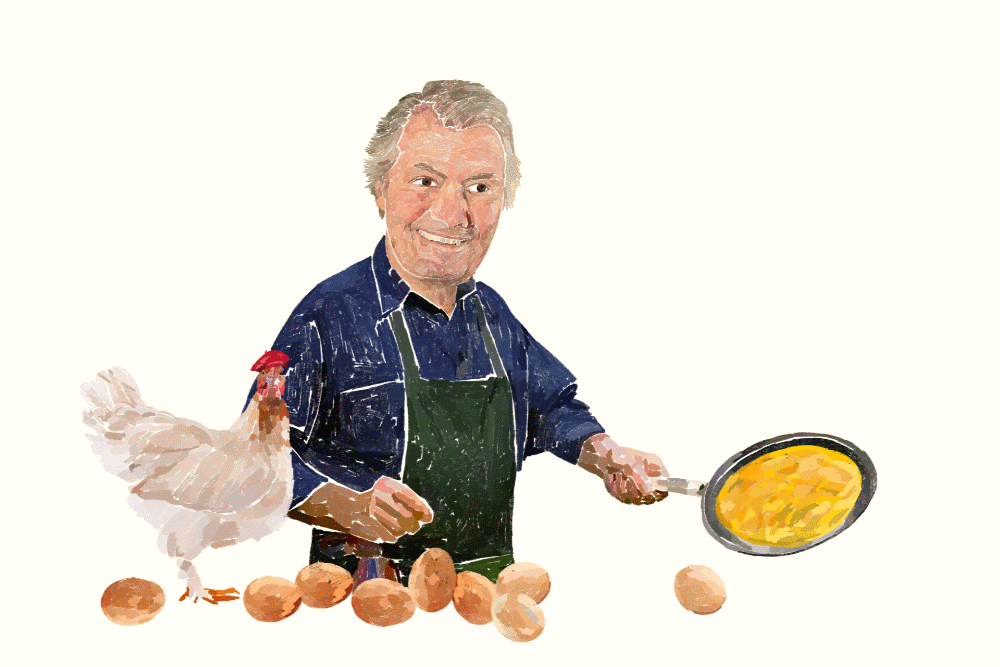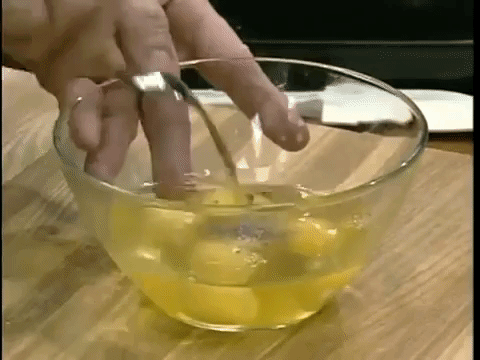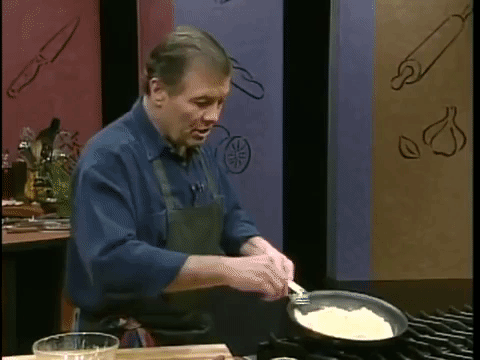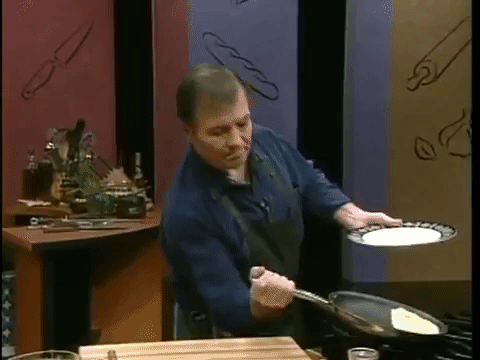
In April of 1995, Jacques Pépin taped a cooking demonstration that detailed how to make an omelet. And while it was merely one of 105 segments the chef recorded over a frantic two-day period in a studio in Northern California, the clip has become one of the most beloved food videos of all time. This is its story.
With eight eggs, a ramekin of Land O’ Lakes butter, a pinch of chopped chives, and a life’s worth of experience amongst the pots and pans, Jacques Pépin walked into the KQED studio in San Francisco and changed the course of eggs in the United States of America forever. At just under six minutes, Pépin’s now-famous omelet segment, recorded in the spring of 1995, is perhaps the single greatest cooking sequence ever to be captured on film. The man made two omelets, and American chefs, food writers, and dedicated home cooks have been inspired for the nearly quarter century since.
The 5:52 segment opens with Pépin walking toward the counter. Hair like Rock Hudson’s, blue denim Levi’s shirt with the sleeves rolled up under a forest-green apron, Pépin is already talking to the camera, as if we caught him midconversation. “If I had to judge how good technically a chef is, I probably would ask him to do an omelet,” he says, with a Lyonnaise accent that is at once authoritative and approachable. As he’s saying this, he approaches the counter and unconsciously starts doing the things a chef does with his hands at his station: a cataloging of the physical objects before him that’s half evaluation and half confirmation of their existence.
He picks up then puts down the fork and the glass bowl, the only two items on the cutting board. He moves the pan—a wide, heavy-bottomed nonstick skillet—onto the front burner of his range, all the while talking to you about omelets, like both you and they were old friends. “I’m going to show you two different types of omelets,” he begins, breaking four eggs into a glass bowl with metronymic regularity, “a kind of country French omelet, which is basically the way we do it in America, and then a classic French omelet. One is not better than the other; it’s just a different technique, a different taste, a different look that you have in it.”
Of course, I don’t have to go on about the video. You’ve seen it. Millions have seen it. Today, you can’t get two whisks into making an omelet before your mind Pavlovianly turns to Pépin, his Gallic vowels, his informal perfection, the benign violence of his fork in yolk as he whisks with vigor. But I do wonder what it is about this segment, one of over 105 filmed during an enormously productive two-day period in the spring of ’95, that continues to echo through larders of our time? Was it just another day in the studio for Pépin, or was it his Dylan ’66 or Simone at Montreux or, I don’t know, Cheap Trick at Budokan?
Certainly it was nothing special for those in the studio. Peter L. Stein, the producer of Pépin’s show on KQED, Today’s Gourmet, admits, “You have to remember, by the time we made what would become the technique series, we’d already shot three 26-part seasons with Jacques in which he demonstrated everything phenomenally, flawlessly, with charm. We had, frankly, gotten a little bit inured.” Tina Salter, at the time the culinary producer, recalls that Pépin was just being Pépin. “He’ll replicate the same thing over and over again,” she says. “Doesn’t matter if it’s in a fancy kitchen, a studio, or a shopping mall.”
The omelet segment itself was drawn from what was initially a public-television pledge-drive special. Pépin had had the idea that instead of a standard recipe-driven show, he’d focus simply on technique. (His books, La Technique and La Methode, had established the man as a master technician.) How to make an omelet was, for instance, preceded by tips for reconstituting broken mayonnaise and followed by vegetable decorations for patés and terrines. These were skills, Pépin told me recently, that had been engraved into his bones like culinary scrimshaw from his years as an apprentice. “It is part of what I do,” he said, “part of who I am. You repeat a technique, then you repeat it and repeat it until it becomes part of you.”
The segment itself is strikingly straightforward. Like each of the other 104 skills, it takes place in a Spartan studio. This was no faux Connecticut kitchen, with pothos plants and chicken-shaped pottery in the background. “This was a reference work,” explains Stein, “so I wanted the set to be spare, clean, and abstract.” A few standing set pieces, sort of flattened columns, occupy the background. They are silk-screened with illustrations of kitchen ephemera (a clove of garlic, a knife, a rolling pin) that the set designer, Ron Haake, had modeled after Pépin’s own illustrations. There is no fancy camera work, just the three cameras rolling simultaneously, shooting to videotape, with few cuts—and the few that occur are purely functional. It’s almost Russian Ark–ian, avant-garde without trying to be.
“It was mostly continuous,” says Salter, “a lesson in its entirety.” Pépin’s language, though fluent, is plain, bordering on folksy. I counted only one simile, no metaphors, and a remarkable dearth of adjectives. It was all improvised, Pépin tells me. (“No, are you kidding?” he says when I ask. “There was never a script.”) And yet it’s a thing of flawless beauty to watch him narrate turning four eggs into two omelets.
And at the end, when he slices open the classic omelet to reveal quivering curds—“curd” in his accent, always singular—and a nice jazz piano riff comes in (the work of a local Bay Area pianist named Mike Greensill), one is moved in a way omelets rarely can. One is emotional. Why? Because as it turns out, Jacques Pépin isn’t teaching us how to make an omelet. He is giving us a lesson in epistemological certainty. This is what it is to know something so profoundly that the knowledge flows from you effortlessly, like water.
The year 1995 was, for me and many Americans my age, a complicated and confusing time. It was the year I turned 14, the year I first kissed a girl, a year I shrouded my spindly legs in JNCO jeans and my avian torso in Alien Workshop, the year I didn’t learn how to heelflip, and the year I lied about it. Was it the year of Crystal Clear Pepsi or the year of Orbitz? I can’t remember. It was the year Doritos introduced a new chip shape. It was the year we all danced to Ini Kamoze’s “Here Comes the Hotstopper” without knowing at all what it was about.
And then, all of a sudden, there’s a French guy on television, talking to me as if we’d already been talking for years now, and in his hands (muscular, knobby) is a pan, a beautiful pan, he says, because it “doesn’t have any corners, you see it has a beautiful sway. It is a nonstick pan, so it’s ideal. It’s an omelet pan, actually.” And he speaks in a direct a way, with a sort of plaintive singsong. But he also speaks with the authority of someone who knows so much he needn’t think, about a topic both quotidian and mystical, and the bruit of the ’90s subsides and it’s just you and Jacques and thin layer of quickly-cooking egg curd.
As demonstrated by Pépin, the perfect omelet is the result not of exalted ingredients—the eggs, says Salter, were from a supermarket aisle—but rather of the alchemy of heat and technique. In this segment, Pépin presents two omelets: a country-style French omelet and a classic French omelet. The country-style omelet—the omelet Pépin tells me today his mother made and his daughter Claudine tells me he made—is earthier, ruder, more grounded. It is browned like the earth, gutsy and rough. It is an omelet with its hands dirty and edges browned. This is the omelet of the 24-hour diner, the omelet served by old ladies with Parliament voices in black vests with tangerine eye shadow who call you “honey.” This is the omelet that accompanies bottomless coffee, endless despair, and hard-fought joy.
The classic French omelet, on the other hand, doesn’t worry about the world’s suffering. Perfect, pristine, coddled. The curds, still creamy, are constantly agitated, and the entire thing quickly turns in on itself. Pépin, as he grasps the skillet handle with an inverted grip, turns it over onto the plate where it quivers like a dauphin prince at court for the very first time: the refined Apollo to the ruddy Dionysus.
Though there is considerable technique deployed in both—not the least of which is loosening the curd from the pan with nothing but a skillfully deployed fork and then simply knocking the pan against the counter until, like a slow motion wave, the edge of the omelet rises and falls back on itself—but there can be no argument that the classic French omelet is the loftier of the two.
Watching and rewatching the segment, I couldn’t put my finger on what, exactly, makes it so striking. Sure, the execution of a task at once difficult and simple is enormously satisfying. But it’s not just the technique. It’s the visceral pleasure felt when the form of a thing and the content of it are perfectly aligned. See, the secret of an omelet is skillful action without fuss.
There are no tricks to the omelet. No shortcuts or hacks. And the secret to teaching the secret of an omelet is the same skillful action, an absence of neuroses and flimflam—and this is what Pépin nails. Plainspoken yet brilliant, humble yet exalted, Pépin is the omelet he makes. So there’s that.
But let us not forget that Pépin didn’t make just one omelet. He made two: a country-style omelet with browned edges and tough curds that you might find in a Howard Johnson’s or a Lyonnaise farmhouse and a classic-style omelet, creamy and ethereal, that you’d find at a place like La Pavillon or at the palace kitchen of Charles de Gaulle.
And the thing was that Pépin, alone among men, had been inside all of these. And what he had to say about them was equanimous. He had been to the mountaintop and in the valley, too, and his ultimate conclusion was this: “One is not really necessarily better than the other,” he says. “It’s a different technique, a different taste.” So here, on the range, embodied by two differing omelets, is the triumph of Aeschylus and Sophocles: the harmony between the Dionysian and Apollonian.
If Helen’s was the face that launched a thousand ships, Pépin’s was the face that folded a million omelets, and this was the moment he went from PBS presence to cultural touchstone. This special, which was eventually released as part of a five-tape VHS box set in 1995 with the name Jacques Pépin’s Cooking Technique, and, with the addition of Jacques Pépin’s Dessert Techniques, as part of a 13-part series in 1997, established Pépin as a culinary heavyweight. These two days in San Francisco began a trajectory that would eventually include Julia and Jacques Cook at Home. But the long term goes further: The segment proves that home cooking could be transformative, and inspired thousands of citizens to take up forks and pans and break eggs.
Jim Oseland, long before he became the editor in chief of Saveur, recalls being in the thrall of Pépin. “I used to watch this show after coming home from a hard day’s work being a copy editor in women’s fashion magazines, when I just needed to dream.” Ignacio Mattos, who serves his own French classic omelet at Estela (albeit with sea urchin), remembers, “watching JP making omelets felt almost as good as eating them. So bare and compelling.” The memory is still so salient in the mind of Gavin Kaysen that in 2011, 15 years after it first aired, his first thought upon learning Pépin was in Café Boulud was “Thank God we took the omelet off the menu!”
As for me and the millions of others who have watched Jacques Pépin make an omelet, of all that happened in the ’90s, it is the well to which we return over and over again and which seems just as fresh today as it did 25 years ago. There are no shortcuts. There are no hacks. There is just hard work and life experience and two different kinds of omelets, neither one of which is better than the other, just as long as they’re well made.




